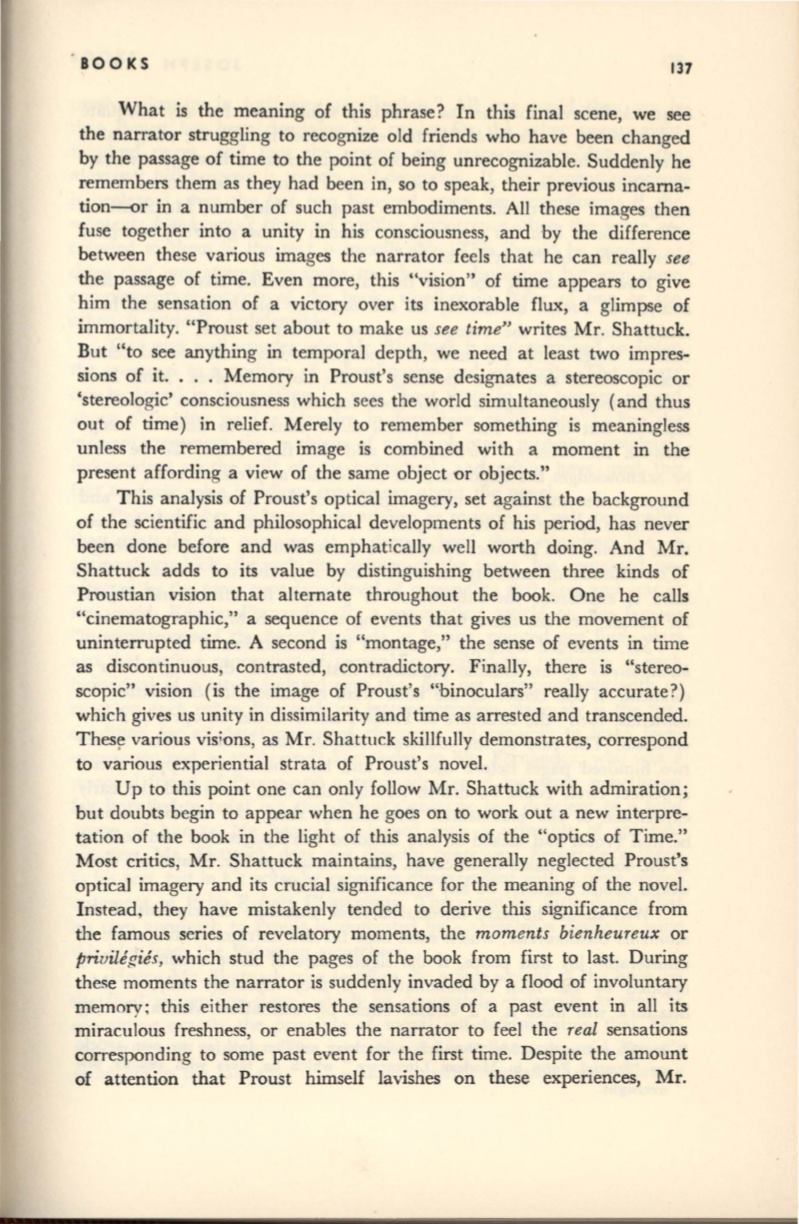
BOOKS
137
What is the meaning of this phrase? In this final scene, we see
the narrator struggling to recognize old friends who have been changed
by the passage of time to the point of being unrecognizable. Suddenly he
remembers them as they had been in, so to speak, their previous incarna–
tion--or in a number of such past embodiments. All these images then
fuse together into a unity in his consciousness, and by the difference
between these various images the narrator feels that he can really
see
the passage of time. Even more, this "vision" of time appears to give
him the sensation of a victory over its inexorable flux, a glimpse of
immortality. "Proust set about to make us
see time"
writes Mr. Shattuck.
But "to see anything in temporal depth, we need at least two impres–
sions of it. . . . Memory in Proust's sense designates a stereoscopic or
'stereologic' consciousness which sees the world simultaneously (and thus
out of time) in relief. Merely to remember something is meaningless
unless the remembered image is combined with a moment in the
present affording a view of the same object or objects."
This analysis of Proust's optical imagery, set against the background
of the scientific and philosophical developments of his period, has never
been done before and was emphatically well worth doing. And Mr.
Shattuck adds to its value by distinguishing between three kinds of
Proustian vision that alternate throughout the book. One he calls
"cinematographic," a sequence of events that gives us the movement of
uninterrupted time. A second is "montage," the sense of events in time
as discontinuous, contrasted, contradictory. Finally, there is "stereo–
scopic" vision (is the image of Proust's "binoculars" really accurate?)
which gives us unity in dissimilarity and time as arrested and transcended.
Thes~
various visions, as Mr. Shattuck skillfully demonstrates, correspond
to various experiential strata of Proust's novel.
Up to this point one can only follow Mr. Shattuck with admiration;
but doubts begin to appear when he goes on to work out a new interpre–
tation of the book in the light of this analysis of the "optics of Time."
Most critics, Mr. Shattuck maintains, have generally neglected Proust's
optical imagery and its crucial significance for the meaning of the novel.
Instead, they have mistakenly tended to derive this significance from
the famous series of revelatory moments, the
moments bienheureux
or
privitegies,
which stud the pages of the book from first to last. During
the~e
moments the narrator is suddenly invaded by a flood of involuntary
memory; th is ei ther restores the sensations of a past event in all its
miraculous freshness, or enables the narrator to feel the
real
sensations
corresponding to some past event for the first time. Despite the amount
of attention that Proust himself lavishes on these experiences, Mr.


